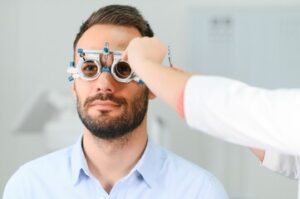Doctors offer a variety of treatment options to help relieve dry eye symptoms. They begin with determining whether an underlying condition (such as Sjogren’s syndrome or lacrimal and meibomian gland dysfunction) is the cause of the dry eye symptoms.

Symptoms can be caused by multiple factors, many of which you can control through lifestyle changes or medication adjustments. Contact Dry Eye Baltimore, MD for professional help.
Healthy eyes have a constant covering of oily tears (tear film) that enables clear vision and prevents the eye from becoming dry. When the tear film is not working correctly, it can cause symptoms of dry eye. The main problems are insufficient tear production or an imbalance in the eye’s natural mixture of oils and water that decreases the rate at which tears evaporate.
The condition can make it feel like there is something in your eyes or that your vision is blurry or shaky. Other symptoms can include burning sensations in the eyes, stringy mucus in the eye or eyelid, red or irritated eyes and eye fatigue. The symptoms tend to be worse late in the day and can affect people who spend time at computers or reading.
Some medications can increase your risk of having dry eyes, especially those for depression, high blood pressure, glaucoma and some birth control pills. The side effects of many over-the-counter drugs can also affect your eyes, such as antihistamines and diuretics. Some diseases, including lupus and scleroderma, can also cause dry eyes.
Symptoms can be eased by using artificial tears or ointments to help lubricate the eyes. These can be bought over the counter and used as directed on the package. In severe cases, prescription eye drops that stimulate the production of tears or alter the makeup of the tears can be prescribed. Other treatment options include the use of moisture chamber glasses, which wrap around the eye to help retain moisture and ointments that can be applied directly to the eyes to relieve symptoms. Oral supplements, such as omega-3 fatty acids, can be helpful in some patients.
The first step in getting help is to visit your GP or optician. They can check what the cause might be and refer you to an ophthalmologist for further tests. You may need to visit several doctors before you find the right treatment for you. It’s important to seek treatment if your symptoms are bad, because untreated chronic dry eye can lead to more serious complications such as corneal ulcers and scarring which could cause permanent changes in your vision.
Causes
Normally, your eyes are covered by a film of oil, water and mucus that lubricates the cornea so you can see clearly. When this tear film is disrupted, it causes symptoms like irritation and blurred vision. Tear production decreases with age, some medical conditions or as a side effect of certain medications. Also, environmental conditions like wind or dry climates can cause tears to evaporate more quickly than they should.
Another common cause is eye infections, such as blepharitis or meibomian gland dysfunction, which can clog these glands and prevent them from producing enough oil to stop tears from evaporating too quickly. These problems are often accompanied by red, flaky skin around the eyelids. You may also experience a feeling of sand or grit in your eyes.
If you have this type of dry eye, it’s important to see an ophthalmologist or optometrist to get diagnosed and treated right away. They can prescribe over-the-counter or prescription eye drops or ointments to help lubricate your eyes and reduce symptoms. They can also recommend changes to your lifestyle, such as using a humidifier or increasing the amount of time you blink. You can also take dietary supplements, such as omega-3 fatty acids or glycerol, which have been shown to decrease dry eye symptoms in some people.
The main goal of treatment is to increase your tear volume and decrease the rate at which your tears evaporate. For this, your ophthalmologist may prescribe medications, such as cyclosporine (Restasis) or xiidra. These medicines stimulate the glands in your eyelids to produce more oil. They can also recommend warm compresses and lid massage to encourage tear production.
Other treatments may include temporary punctal occlusion, which involves closing the small hole in the duct that drains your tears. This will allow your body to slowly create more tears over a period of time. If your symptoms don’t improve with other therapies, your doctor may want to try permanent punctal occlusion. They will start with a temporary plug designed to dissolve over time, and then will evaluate whether the procedure is working.
Treatment
There is no cure for dry eye syndrome, but there are a variety of treatments that can relieve the symptoms and improve your quality of life. Treatments aim to increase tear production, maintain the natural tear film or prevent excess tear loss. Treatment may include prescription eye drops or ointments, warm compresses and/or lid massage using ophthalmic lubricants. Depending on the cause of your symptoms, other treatment options may include dietary supplements such as Omega 3 fatty acids (available in many forms including capsules, gels and ointments).
Your doctor will diagnose dry eye during a comprehensive exam that includes a review of your medical history and a visual examination of your eyes. They will likely recommend the use of a special dye to better see your tear film and check the health of your eyelids and cornea. Other tests that may be used are the slit lamp test and the Schirmer tear breakup time test, which measures your tear film by placing filter paper between your lower eyelid and your eye, then measuring how long the paper takes to absorb the tears.
Dry eye symptoms can also be caused by the way you blink or because of certain medications or medical conditions. For example, if you are wearing contact lenses, it is important to blink frequently and remove them regularly to keep your eyes moist. This is particularly important when reading or working at a computer because the lack of blinking can lead to dry eyes.
People with a condition called blepharitis, which is an inflammation of the eyelids, can have dry eyes and may have a scaly or crusty appearance on their eyelashes. If this is the case for you, your doctor may recommend a special cleaning regime to manage blepharitis or refer you to an oculoplastic surgeon who specializes in treating the eyelids.
Other common causes of dry eye include age, environmental factors such as windy or dry weather and the use of medications such as antihistamines, decongestants, blood pressure medication and birth control pills. If you have any of these conditions, your doctor will discuss how to best manage them to reduce the impact on your eye health and your quality of life.
Prevention
The primary treatment for dry eye involves restoring a more normal tear film, which helps minimize discomfort and blurred vision. This typically includes over-the-counter artificial tears, which can be purchased in both preserved and unpreserved forms, as well as prescription medications that may increase tear production or reduce inflammation. In some cases, a physician may also recommend a humidifier to help introduce moisture into the air.
Other measures may include using a warm compress on the eyes, blinking more frequently, and limiting screen time. In addition, avoiding second-hand smoke, direct wind, and air conditioning can all improve symptoms. Patients should also avoid certain medicines, such as those for allergies or colds, which can irritate the eyes. Dietary changes incorporating omega-3 fatty acids can decrease dry eye discomfort in some individuals, although this should be discussed with your doctor to determine the proper dosage.
In more severe cases, a person’s doctor may recommend surgery to permanently plug the drainage holes in their eyelids (punctal plugs). This is an outpatient procedure and can be performed painlessly by a qualified ophthalmologist.
Some medications, such as those for depression, blood pressure, glaucoma, and allergies, can cause dry eye. Hormonal changes related to menopause, pregnancy, and oral contraceptives can also raise the risk. Additionally, some surgical procedures can contribute to dry eye symptoms, including LASIK and cataract surgery.
In addition to the treatments above, your doctor may also prescribe other medications, such as LipiFlow or BlephEx, which can increase tear production, as well as cyclosporine, an anti-inflammatory medication that reduces inflammation. In addition, doctors may also recommend a dietary modification to incorporate more omega-3 fatty acids or to reduce the amount of inflammatory foods that are eaten. Finally, some patients benefit from a procedure called a punctal plug (or lacrimal plug). This is an in-office procedure that involves inserting small plugs into the drainage holes at the corners of the eyelids. This prevents tears from draining away too quickly and allows them to remain on the eye longer. This can significantly improve symptoms for many people. In other cases, a doctor may also recommend an eyelid massage or a special treatment to reduce inflammation.





